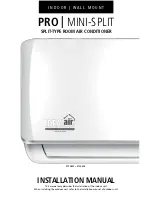
36
Caution Before Connecting Tubes Tightly
(1) Apply a sealing cap or water-proof tape to prevent dust or water from
entering the tubes before they are used.
(2) Be sure to apply refrigerant lubricant to the matching surfaces of the flare
and union before connecting them together. This is effective for reducing
gas leaks.
(3) For proper connection, align the union tube and flare tube straight with each
other, then screw in the flare nut lightly at first to obtain a smooth match.
●
Adjust the shape of the liquid tube using a tube bender at the installation
site and connect it to the liquid tubing side valve using a flare.
Cautions During Brazing
●
Replace air inside the tube with nitrogen gas to prevent copper
oxide film from forming during the brazing process. (Oxygen, carbon
dioxide and Freon are not acceptable.)
●
Do not allow the tubing to get too hot during brazing.
The nitrogen gas inside the tubing may overheat, causing refrigerant
system valves to become damaged.
Therefore allow the tubing to cool when brazing.
●
Use a reducing valve for the nitrogen cylinder.
●
Do not use agents intended to prevent the formation of oxide film.
These agents adversely affect the refrigerant and refrigerant oil, and
may cause damage or malfunctions.
5-2. Connecting Tubing Between Indoor and Outdoor Units
(1) Tightly connect the indoor-side refrigerant tubing
extended from the wall with the outdoor-side
tubing.
(2) To fasten the flare nuts, apply specified torque as at right:
●
When removing the flare nuts from the tubing
connections, or when tightening them after connecting the
tubing, be sure to use a torque wrench and a spanner.
If the flare nuts are over-tightened, the flare may be
damaged, which could result refrigerant leakage and
cause in injury or asphyxiation to room occupants.
●
For the flare nuts at tubing connections, be sure to use
the flare nuts that were supplied with the unit, or else flare
nuts for R410A (type 2).
The refrigerant tubing that is used must be of the correct
wall thickness as shown in the table at right.
Because the pressure is approximately 1.6 times higher than conventional refrigerant pressure, the use of ordinary flare nuts
(type 1) or thin-walled tubes may result in tube rupture, injury, or asphyxiation caused by refrigerant leakage.
●
In order to prevent damage to the flare caused by over-tightening of the flare nuts, use the table above as a guide when
tightening.
●
When tightening the flare nut on the liquid tube, use an adjustable wrench with a nominal handle length of 7-7/8" (200 mm).
Apply refrigerant
lubricant
Union
Flare nut
Torque wrench
Spanner
Outdoor unit
Indoor unit
Tube
diameter
in. (mm)
Tightening torque, approximate
Tube thickness
lbs · in.
N · m
{k
g
f · cm}
inch
mm
ø1/4
(ø6.35)
120 – 160
14 – 18
{140 – 180}
0.025
0.635
ø3/8
(ø9.52)
300 – 360
34 – 42
{340 – 420}
0.030
0.762
ø1/2
(ø12.7)
430 – 610
49 – 61
{490 – 610}
0.035
0.889
ø5/8
(ø15.88)
590 – 710
67 – 81
{680 – 820}
0.040
1.016
ø3/4
(ø19.05)
870 – 1040 99 – 118
{1000 – 1200}
0.042
1.0668
01_302412_Eng.indd 36
2018/7/4 13:30:52
















































